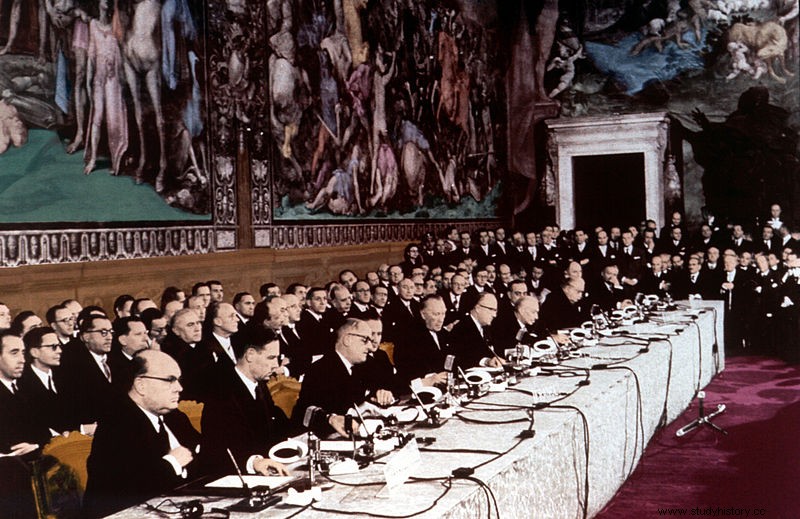- 1951:signing of the Treaty of Paris which created the European Coal and Steel Community (ECSC), an organization which aims to support inter-European trade and prevent future war through the integration of Six members :Belgium, France, the FRG, Italy, Luxembourg and the Netherlands.
- 1954:failure of the constitution of a political Europe when the French parliament rejects the project of a European Defense Community (EDC)
- 1955:interministerial meeting of the six ECSC member states to resolve the problems caused by the failure of the EDC. This Messina conference lays down the principles of a united Europe in the economic field by considering the creation of a common market.
- 1956:Paul-Henri Spaak, Belgian minister, issues a report (Spaak report) on the European customs union, which provides for the creation of two communities, one for the common market and the other for nuclear energy. This report lays the foundations for the Treaty of Rome.
- 1956:The Intergovernmental Conference for the Common Market and Euratom opens under the authority of Paul-Henri Spaak at the Château du Val Duchesse in Belgium. France is at the center of the negotiations and is hostile to the disappearance of customs barriers. These negotiations prepare the signing of the Treaty of Rome.
March 25, 1957

Characters
Paul-Henri Spaak
Konrad Adenauer
Jean Monnet
Procedure
After the Val Duchesse negotiations, the representatives of the Europe of the Six met on March 25, 1957 in Rome to sign two separate treaties, one relating to the creation of the common market (the EEC, European Economic Community), the another on the establishment of Euratom (European Atomic Energy Community, or CEEA). It is therefore more accurate to speak of the Treaties of Rome, rather than using the singular.
The main purpose of the treaty establishing the common market is to provide the legal framework with which goods can access free movement in Europe. The end of customs barriers between the six Member States is thus envisaged. This treaty also lays the foundations for common policies that will be developed later.
Euratom, on the other hand, was born of the French ambition to ensure European cooperation in civil nuclear matters to ensure the continent's energy self-sufficiency. France also hoped that European financial support for civilian nuclear power would enable it to gain faster access to atomic weapons. The Treaty of Rome takes place in the context of the Cold War (Budapest uprising, 1956), and the tensions caused by the antagonism of the two blocs greatly influence the construction of a third bloc, Europe.
Consequences
- 1958:the Stresa conference uses the bases of the Treaty of Rome to launch the Common Agricultural Policy (CAP), which comes into force in 1962.
- 1973:first enlargement with the entry of the United Kingdom, Denmark and Ireland.
- 1986:The Single European Act deepens the common market, henceforth naming it the "internal market".
- 1992:creation of a European citizenship by the Treaty of Maastricht.
- 1995:the Schengen Convention allows the free movement of people within the Member States.
